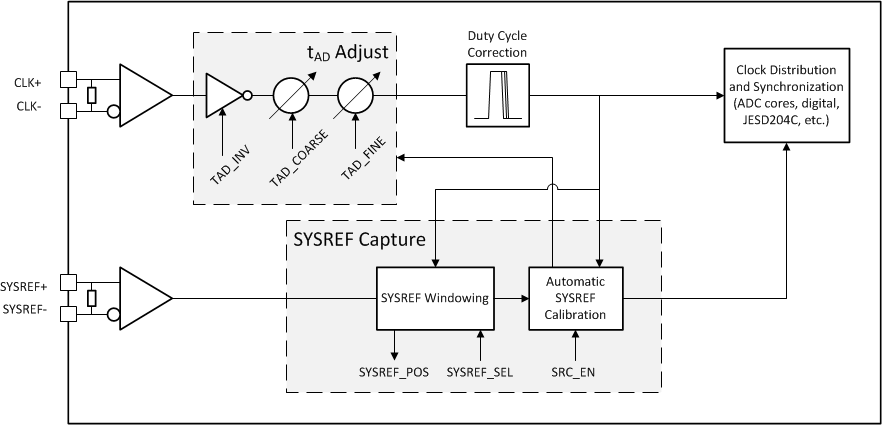SLVSEO0C August 2021 – June 2024 ADC12DJ4000RF
PRODUCTION DATA
- 1
- 1 Features
- 2 Applications
- 3 Description
- 4 Device Comparison
- 5 Pin Configuration and Functions
-
6 Specifications
- 6.1 Absolute Maximum Ratings
- 6.2 ESD Ratings
- 6.3 Recommended Operating Conditions
- 6.4 Thermal Information
- 6.5 Electrical Characteristics: DC Specifications
- 6.6 Electrical Characteristics: Power Consumption
- 6.7 Electrical Characteristics: AC Specifications (Dual-Channel Mode)
- 6.8 Electrical Characteristics: AC Specifications (Single-Channel Mode)
- 6.9 Timing Requirements
- 6.10 Switching Characteristics
- 6.11 Typical Characteristics
-
7 Detailed Description
- 7.1 Overview
- 7.2 Functional Block Diagram
- 7.3
Feature Description
- 7.3.1 Analog Inputs
- 7.3.2 ADC Core
- 7.3.3 Temperature Monitoring Diode
- 7.3.4 Timestamp
- 7.3.5 Clocking
- 7.3.6 Programmable FIR Filter (PFIR)
- 7.3.7 Digital Down Converters (DDC)
- 7.3.8
JESD204C Interface
- 7.3.8.1 Transport Layer
- 7.3.8.2 Scrambler
- 7.3.8.3 Link Layer
- 7.3.8.4 8B/10B Link Layer
- 7.3.8.5
64B/66B Link Layer
- 7.3.8.5.1 64B/66B Encoding
- 7.3.8.5.2 Multiblocks, Extended Multiblocks and the Local Extended Multiblock Clock (LEMC)
- 7.3.8.5.3 Block, Multiblock and Extended Multiblock Alignment using Sync Header
- 7.3.8.5.4 Initial Lane Alignment
- 7.3.8.5.5 Block, Multiblock and Extended Multiblock Alignment Monitoring
- 7.3.8.6 Physical Layer
- 7.3.8.7 SerDes Pre-Emphasis
- 7.3.8.8 JESD204C Enable
- 7.3.8.9 Multi-Device Synchronization and Deterministic Latency
- 7.3.8.10 Operation in Subclass 0 Systems
- 7.3.9 Alarm Monitoring
- 7.4
Device Functional Modes
- 7.4.1 Dual-Channel Mode
- 7.4.2 Single-Channel Mode (DES Mode)
- 7.4.3 Dual-Input Single-Channel Mode (DUAL DES Mode)
- 7.4.4 JESD204C Modes
- 7.4.5 Power-Down Modes
- 7.4.6 Test Modes
- 7.4.7 Calibration Modes and Trimming
- 7.4.8 Offset Calibration
- 7.4.9 Trimming
- 7.5 Programming
- 7.6 SPI Register Map
- 8 Application Information Disclaimer
- 9 Device and Documentation Support
- 10Revision History
- 11Mechanical, Packaging, and Orderable Information
Package Options
Mechanical Data (Package|Pins)
- ZEG|144
- AAV|144
Thermal pad, mechanical data (Package|Pins)
Orderable Information
7.3.5 Clocking
The clocking subsystem of the device has two input signals, device clock (CLK+, CLK–) and SYSREF (SYSREF+, SYSREF–). Within the clocking subsystem there is a noiseless aperture delay adjustment (tAD adjust), a clock duty cycle corrector and a SYSREF capture block. Figure 7-2 describes the clocking subsystem.
 Figure 7-2 Clocking Subsystem
Figure 7-2 Clocking SubsystemThe device clock is used as the sampling clock for the ADC core as well as the clocking for the digital processing and serializer outputs. Use a low-noise (low jitter) device clock to maintain high signal-to-noise ratio (SNR) within the ADC. In dual-channel mode, the analog input signal for each input is sampled on the rising edge of the device clock. In single-channel mode, both the rising and falling edges of the device clock are used to capture the analog signal to reduce the maximum clock rate required by the ADC. A noiseless aperture delay adjustment (tAD adjust) allows the user to shift the sampling instance of the ADC in fine steps in order to synchronize multiple ADC12DJ4000RFs or to fine-tune system latency. Duty cycle correction is implemented in the device to ease the requirements on the external device clock while maintaining high performance. Table 7-4 summarizes the device clock interface in dual-channel mode and single-channel mode.
| MODE OF OPERATION | SAMPLING RATE VS fCLK | SAMPLING INSTANT |
|---|---|---|
| Dual-channel mode | 1 × fCLK | Rising edge |
| Single-channel mode | 2 × fCLK | Rising and falling edge |
SYSREF is a system timing reference used for JESD204C subclass-1 implementations of deterministic latency. SYSREF is used to achieve deterministic latency and for multi-device synchronization. SYSREF must be captured by the correct device clock edge in order to achieve repeatable latency and synchronization. The ADC12DJ4000RF includes SYSREF windowing and automatic SYSREF calibration to ease the requirements on the external clocking circuits and to simplify the synchronization process. SYSREF can be implemented as a single pulse or as a periodic clock. In periodic implementations, SYSREF must be equal to, or an integer division of, the local multiframe clock frequency in 8B/10B encoding modes or the local extended multiblock clock frequency in 64B/66B encoding modes. Equation 2 is used to calculate valid SYSREF frequencies in 8B/10B encoding modes and Equation 3 in 64B/66B encoding modes.


where
- R and F are set by the JMODE setting (see JESD204C Operating Modes Table)
- fCLK is the device clock frequency (CLK±)
- K is the programmed multiframe length (see JESD204C Operating Modes Table for valid K settings)
- E is the number of multiblocks in an extended multiblock.
- n is any positive integer